Planning your own trip? Prepare for your trip
Use Rough Guides' trusted partners for great rates
Plan and book your private, tailor-made tour with vetted local experts
Guimarães wears its history with pride. Known as the birthplace of Portugal, this is where Dom Afonso Henriques, the country’s first king, was born in 1110, and where the fledgling kingdom of Portucale took its first steps. The motto “Portugal nasceu aqui”, Portugal was born here, is woven into the city’s identity, and the old center lives up to the claim. A maze of cobbled lanes, honey-colored stone houses, medieval towers, and graceful squares has earned Guimarães UNESCO World Heritage status, making it one of the most evocative historic towns in the country.
Yet Guimarães is far from frozen in time. Restored monasteries now host art exhibitions, contemporary design shops sit beside centuries-old arcades, and the university fills the streets with youthful energy. The nightlife hums with bars and music venues, and each May, the student festivities spill across the squares in a riot of color. If your Porto and North Portugal tour includes Guimarães, expect more than history: it’s the blend of old and new that makes this city unforgettable.

Hey, I’m Sara, your Portugal travel expert, and if you’re drawn to places where history and atmosphere go hand in hand, Guimarães should be on your radar. Often called the birthplace of Portugal, it’s a city where medieval walls, Romanesque churches, and centuries-old mansions sit comfortably beside lively cafés and buzzing student bars. This Guimarães travel guide covers the essentials: how to get there, what to see, and where to stay.
Guimarães is best explored slowly. Stroll through cobbled streets that lead from the imposing castle to shaded squares, pause at a terrace café to watch daily life unfold, and let the climb up to Penha Mountain reward you with sweeping views. The city’s UNESCO-listed center holds the big landmarks like the Ducal Palace and the medieval tower, but it’s the small details that often leave the strongest memories: azulejo-clad doorways, neighbors chatting across balconies, or the sound of bells echoing through stone alleys at dusk.
Sara’s tip
Visit the main square, Largo da Oliveira, in the evening. The day crowds will have faded, and the cafés spill into the square, making it the perfect spot for a glass of vinho verde and some people-watching.
Best time to visit
Spring (April-June) and autumn (September-October) bring mild weather, clear skies, and lively cultural events. July and August are warm and popular, especially during festivals, while winter is quieter and atmospheric, ideal if you want the historic streets to yourself.
How to get to Guimarães
Guimarães is about 55 km from Porto. Regular trains run from Porto’s São Bento station, taking just over an hour. Driving gives you the flexibility to explore the surrounding Minho region, with a travel time of around 50 minutes. Buses also connect Guimarães with Braga, Porto, and Lisbon.
Best areas to stay in Guimarães
Guimarães sits in northern Portugal’s Minho region, about 55 km northeast of Porto and easily reached by train, bus, or car. Nestled at the foot of Penha Mountain, the city blends its medieval heart with a lively modern character, making it both historic and full of energy.
Often listed among the best places to visit in Portugal, Guimarães is a highlight of any northern Portugal itinerary. From here, you can explore nearby Braga with its Baroque sanctuaries, hike the trails of Penha Mountain for sweeping views, or venture deeper into the Minho countryside with its vineyards, rivers, and charming villages.


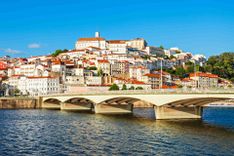
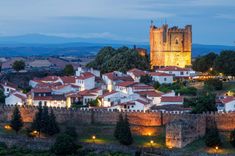

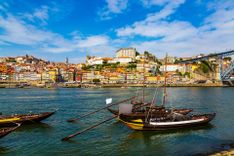










Guimarães is compact, walkable, and designed to be explored on foot. The medieval core is a UNESCO World Heritage Site, so cars are restricted, leaving its cobbled squares and narrow streets to pedestrians. The town is bigger than a hilltop village like Monsanto, but still small enough that you can cross the historic center in 15-20 minutes.
If you’re wondering how many days in Guimarães are enough, one full day will let you see the essentials without feeling rushed: the medieval castle, the Paço dos Duques (Ducal Palace), Largo da Oliveira, and a stroll through the UNESCO-listed old town. Add in the cable car ride up Penha Mountain for sweeping views, and you’ll have covered the highlights.
That said, Guimarães really shines if you linger. Staying overnight lets you enjoy the old squares once the day-trippers leave, when cafés spill into the streets and the atmosphere feels more local. Two days is ideal, giving you time not just for the historic center but also for side trips: Braga is just 25 minutes away, or you could explore the Minho countryside, dotted with vineyards, manor houses, and small villages.

Piazza Largo da Oliveira and church of Nossa Senhora da Oliveira in Guimarães © Shutterstock
Guimarães has a great mix of boutique hotels, historic pousadas, and budget-friendly guesthouses. Most are concentrated in or around the medieval core, but you’ll also find country estates in the surrounding Minho countryside. Here’s where to base yourself depending on your style of travel:
Guimarães may be compact, but it’s one of the most layered and rewarding places to explore in Portugal. Known as the “birthplace of the nation,” it balances medieval heritage with vibrant modern culture, making it a city where you can step between centuries within a single stroll. Here’s the detailed list of the best things to do in Guimarães, each offering its own perspective on why this UNESCO-listed city is so special.
No trip to Guimarães is complete without standing on the battlements of its 10th-century castle. This fortress, with its angular granite walls and seven towers, was built to guard the fledgling territory of Portucale against attacks from the Moors and Normans. It’s also linked to Dom Afonso Henriques, Portugal’s first king, who was born nearby.
Walking through the castle feels like stepping into the nation’s origin story. The views from the towers stretch over the city and surrounding hills, a reminder of why this location was chosen for defense. Go early in the morning for quieter visits, or close to sunset when the stone glows golden and the atmosphere feels almost timeless.
Just downhill from the castle sits the 15th-century Paço dos Duques de Bragança, one of Portugal’s most striking palaces. Its distinctive chimneys rise like stone spears above the roofline, while inside you’ll find vast halls filled with medieval tapestries, Flemish furniture, and ornate ceilings that showcase the wealth of the dukes.
It’s worth taking your time here. The palace doesn’t just display objects but tells the story of a noble family whose influence reached across Portugal and into Brazil. The Great Hall and Banquet Room give you a sense of medieval pomp, while the small chapel offers a more intimate space for reflection.
These two adjoining squares form the heart of Guimarães’ historic center, and they’re among the most atmospheric plazas in Portugal. Largo da Oliveira is named after the ancient olive tree at its center, next to a 14th-century Gothic shrine commemorating a battle victory. Praça de Santiago, meanwhile, was once the gathering point for pilgrims on their way to Santiago de Compostela.
Surrounded by arcaded houses with wooden balconies and tiled facades, the squares are perfect for slow coffees or late-afternoon wine. Sit outside and watch life unfold, students laughing over beers, families strolling after dinner, and musicians bringing the cobbles to life. At night, the lanterns and shadows make it feel like a stage set from centuries past.
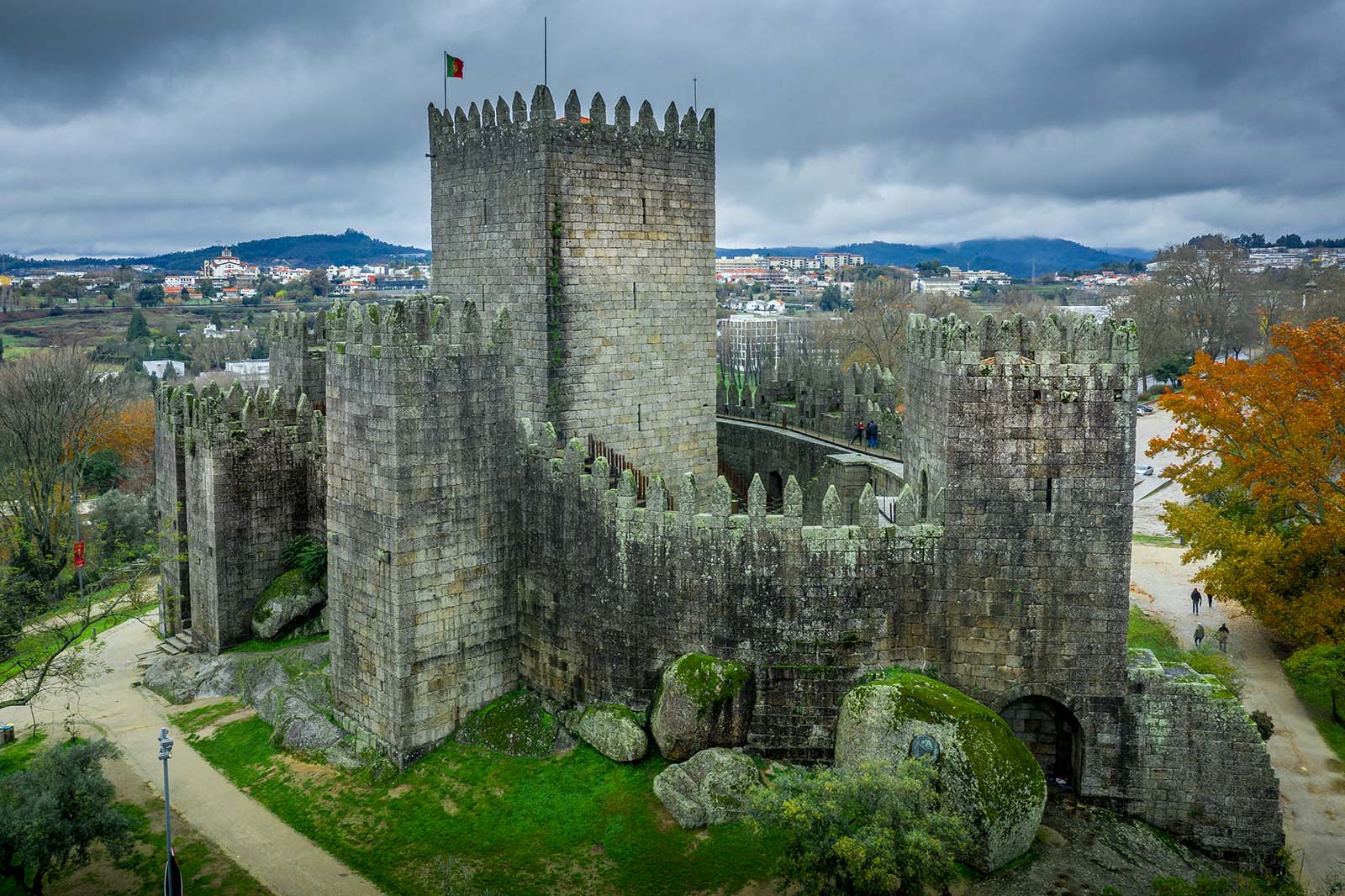
Aerial view of well-preserved medieval buildings hilltop, 10th-century Guimarães Castle © Shutterstock
On the edge of Largo da Oliveira stands one of Guimarães’ most important churches. Originally founded in the 10th century as a monastery, it has been rebuilt and expanded over the centuries, blending Romanesque, Gothic, and later styles. Inside, the altarpiece and gilded details reflect the wealth of the city’s religious history.
The church is not just about architecture; it’s a place where you can feel the centuries of devotion layered into the stone. If you’re lucky, you might catch the organ being played, filling the space with a sound that echoes far beyond the walls.
Housed in the former cloisters of the monastery, this museum is a hidden gem that many visitors miss. Its collection includes medieval art, textiles, and religious treasures, but the standout is the 14th-century tunic said to have been worn by Dom João I at the Battle of Aljubarrota.
The museum itself is an atmospheric place to wander: cloistered courtyards with orange trees, quiet chapels with painted ceilings, and galleries that mix reverence with storytelling. It’s an essential stop if you want to connect Guimarães’ monuments with the human stories behind them.
For a change of pace, take the cable car from the city up to Penha Mountain. The ride itself gives you sweeping views over Guimarães and the Minho countryside, but the real magic begins at the top. Trails wind through giant granite boulders and oak forests, leading to viewpoints, picnic spots, and even a sanctuary.
It’s one of the best spots to see the city from above and a reminder of how nature and history coexist here. If you’re into walking trails, Penha also offers some of the best hiking in Portugal without straying far from town. In summer, locals come up for fresh air and barbecues among the rocks.
Guimarães may be steeped in medieval history, but it also has a modern cultural pulse. The Centro Cultural Vila Flor, housed in an 18th-century palace with lush gardens, is the city’s hub for theater, dance, and music. It gained international attention during the city’s role as European Capital of Culture in 2012.
Even if you don’t attend a performance, the gardens are worth visiting. They’re free, beautifully kept, and offer great views back over the old town, a quiet spot to pause after exploring.
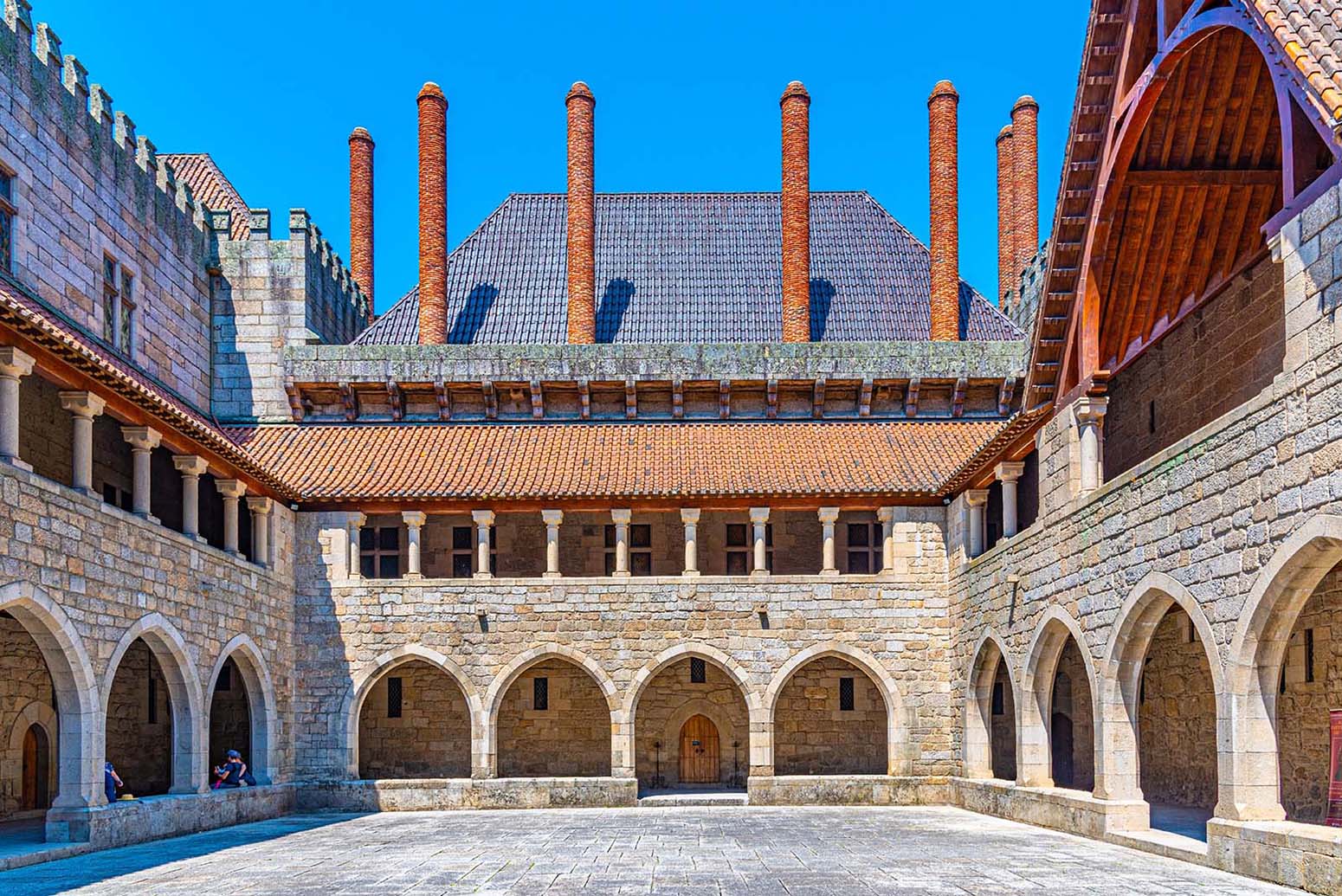
Courtyard of the palace of duques of Braganca in Guimaraes, Portugal © Shutterstock
UNESCO recognition wasn’t just given for the castles and palaces. The real charm of Guimarães lies in its everyday streets. Wander Rua de Santa Maria, one of the oldest thoroughfares, where noble houses mix with artisan workshops. Look up to see wrought-iron balconies, azulejo panels, and centuries-old door knockers in the shape of hands.
Don’t worry too much about following a map; the joy here is in discovery. A quiet courtyard might open onto a fountain, a hidden chapel, or a mural reminding you that Guimarães is as contemporary as it is historic.
Thanks to its university, Guimarães has a youthful energy that comes alive in the evenings. Small bars line the old town streets, often spilling out into the squares in summer. Praça de São Tiago is particularly lively, with locals, students, and visitors mingling over craft beers and vinho verde.
If you’re here in late May, the city transforms for “Semana Académica,” the student festival with parades, concerts, and a carnival-like atmosphere. Even outside festival season, the nightlife balances traditional taverns with modern spots, making it one of the best small cities in Portugal for after-dark fun.
Guimarães makes a great base for exploring northern Portugal. Just 25 minutes away, Braga offers Baroque churches and one of the country’s most iconic sanctuaries, Bom Jesus do Monte. The surrounding Minho countryside, meanwhile, is dotted with vineyards producing vinho verde, as well as river valleys perfect for hiking and kayaking.
Combining Guimarães with these nearby spots gives you a broader sense of the Minho region, where Portugal’s history, culture, and landscapes weave together seamlessly.
Monsanto has a Mediterranean climate with continental influence: hot, dry summers, mild but wetter winters, and sharper day-to-night temperature swings than coastal cities. At 758m elevation, it’s cooler than the plains below in summer, but winter nights can dip near freezing. Average highs range from 45°F (7°C) in January to 84°F (29°C) in August.
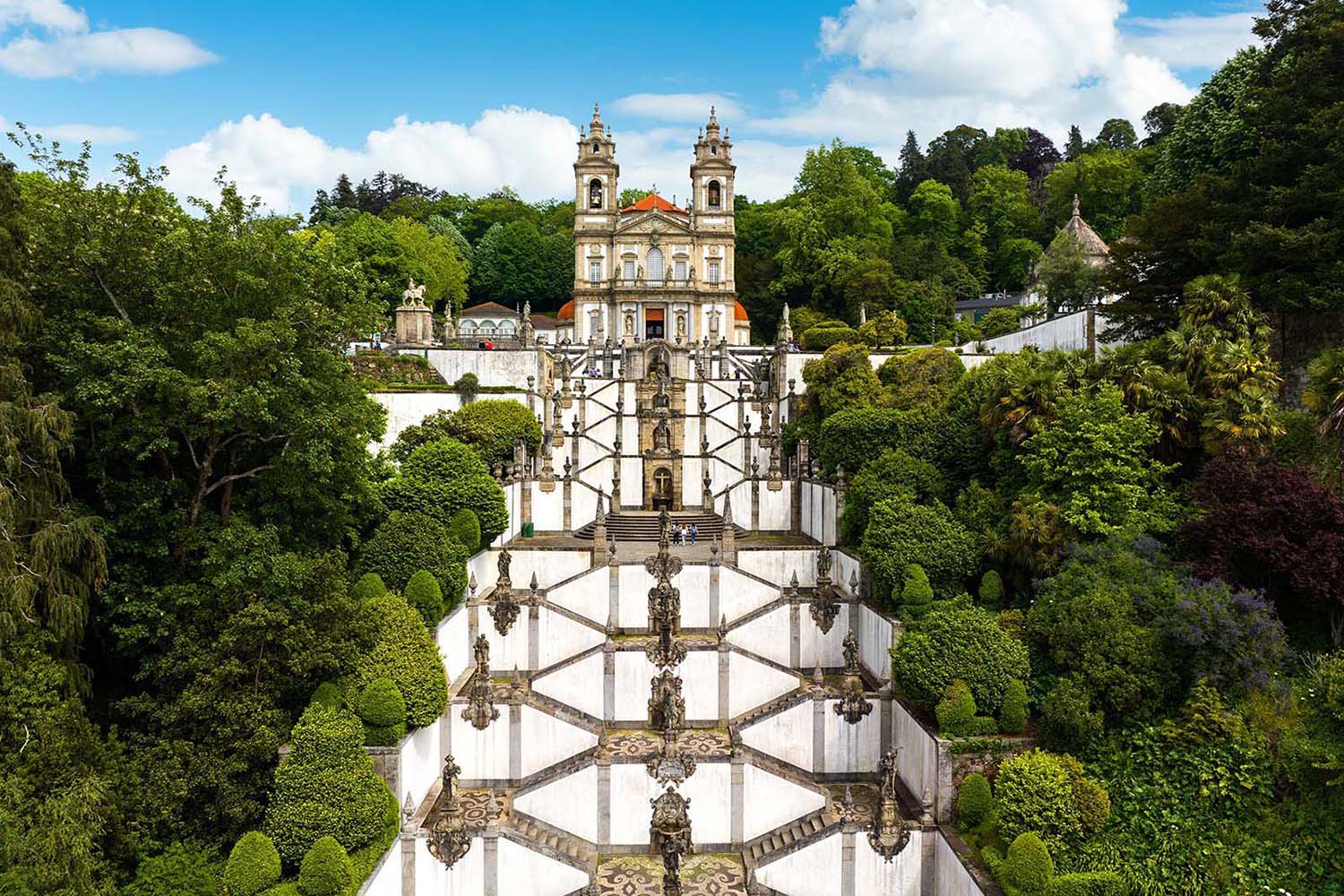
View of the Sanctuary of Bom Jesus do Monte in Braga, Portugal © Shutterstock
Guimarães has a lively food scene that blends hearty Minho traditions with a growing number of contemporary restaurants. Expect northern Portuguese classics like bacalhau (codfish), roasted meats, and dishes made with the region’s famous vinho verde (young green wine). In the historic center, you’ll find taverns tucked into medieval houses, while the outskirts host elegant restaurants that reinterpret regional flavors.
Here are some unique private experiences our local experts can arrange for your tailor-made Guimarães trip: flexible, immersive, and designed to bring history to life.
Discover Portugal's most captivating stories
Use Rough Guides' trusted partners for great rates
written by
Olga Sitnitsa
Online editor at Rough Guides, specialising in travel content. Passionate about creating compelling stories and inspiring others to explore the world.